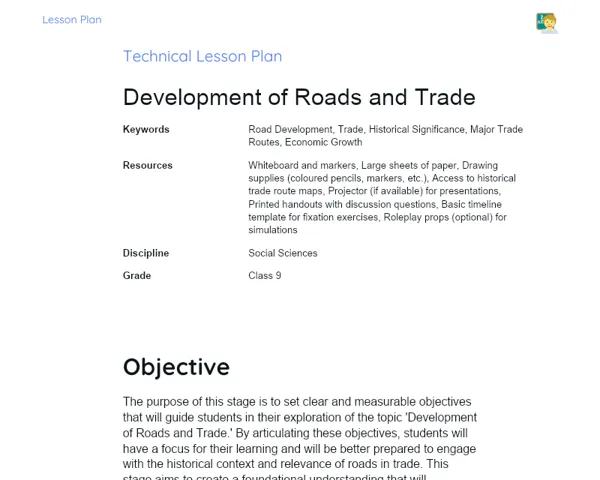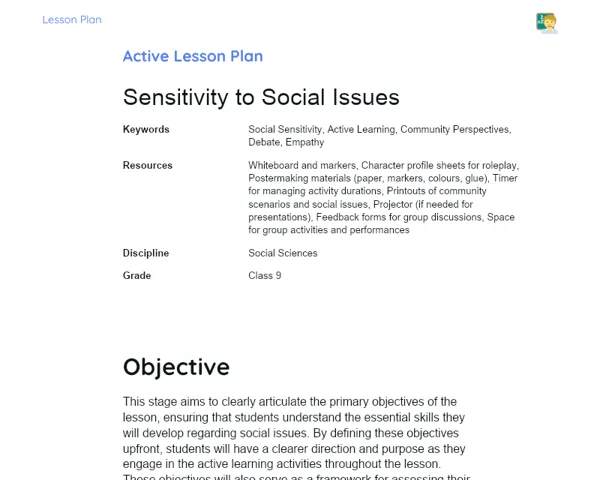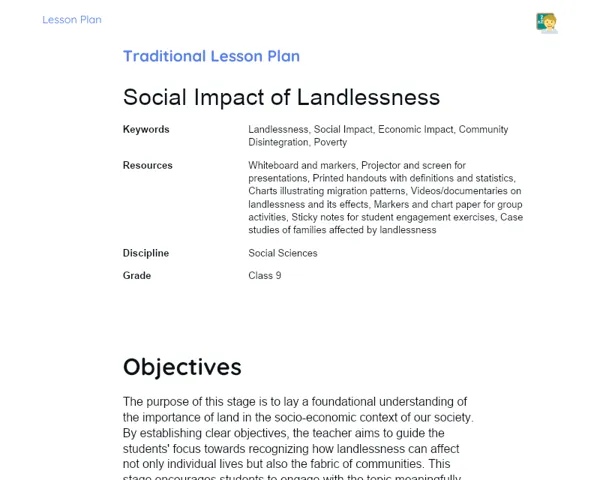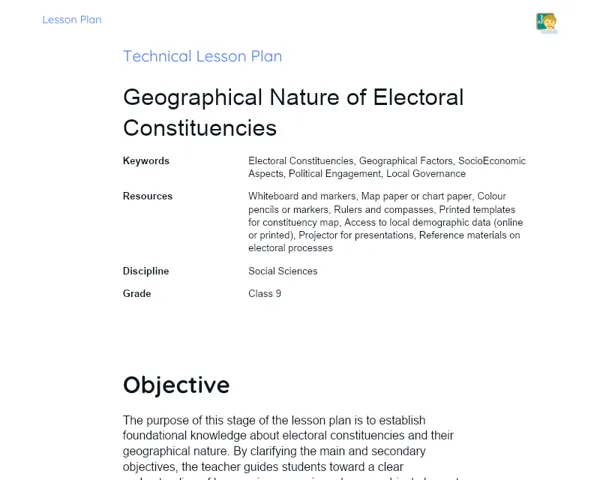Technical Lesson Plan | Impact of Soil Fertility
| Palavras Chave | Soil Fertility, Agriculture, Crop Yield, Sustainable Farming, Soil Management, Nutrients, Organic Matter, Local Farming Practices, Community Economy, Practical Application |
| Materiais Necessários | Blackboard and chalk, Markers, Paper and pens for students, Access to soil samples (if available), Agricultural textbooks or handouts on soil fertility, Presentation tools (e.g., projector, computer) if necessary, Visual aids illustrating soil types and nutrient cycles, Case studies of local farmers (printed handouts or digital access) |
Objective
Duration: (10 - 15 minutes)
The purpose of this stage is to establish a clear understanding of the fundamental concepts related to soil fertility among students. By addressing the main and secondary objectives, students will gain insight into how soil health affects agricultural output, which is crucial for their academic learning in Social Sciences and practical knowledge for future job opportunities in agricultural sectors. This foundational knowledge will help them appreciate the role that soil plays in the ecosystem and the economy, particularly in their local context.
Main Objectives:
1. Understand the importance of soil fertility in agriculture and its direct impact on crop yield and quality.
2. Identify the factors that contribute to soil fertility and how they affect sustainable farming practices.
3. Recognize the significance of soil management in enhancing agricultural productivity.
Side Objectives:
- Discuss local farming practices and how they relate to soil fertility.
- Explore case studies of successful farmers in the region who have improved their soil fertility.
Introduction
Duration: (10 - 15 minutes)
The purpose of this stage is to create a foundational understanding of soil fertility by contextualizing its importance in the students' daily lives and the broader agricultural landscape. By sparking curiosity and interest in agricultural practices, students will be better prepared to delve deeper into the topic and appreciate the intricate relationship between soil health and crop production. This initial engagement aims to make the students aware of the relevance of soil management in their community and future career opportunities in the agricultural sector.
Curiosities and Market Connection
Did you know that the quality of soil can impact the nutrient content of the crops we consume? For instance, crops grown in nutrient-rich soil not only yield more but also possess better taste and nutritional value. With the growing demand for organic produce, this knowledge is essential for students interested in pursuing careers in agriculture, agronomy, or environmental sciences. Understanding soil fertility can open doors to various job opportunities in sustainable farming, agricultural consulting, and food production industries.
Contextualization
Soil fertility is a vital aspect of agriculture, which serves as the backbone of our society, especially in rural areas like India. As many students hail from agricultural families or communities, understanding soil health provides them a direct insight into the practices that influence their livelihoods. Quality soil leads to bountiful crops, which in turn support local economies. This lesson aims to help students grasp the significance of soil fertility in producing the food we eat and the impact it has on local farmers and the overall economy.
Initial Activity
Begin with a quick brainstorming session. Ask students to think about the different fruits and vegetables they consume regularly. Write down their responses on the blackboard. For each item, ask them to guess what type of soil it might require for optimal growth. This activity encourages students to connect familiar foods with agricultural practices, enhancing their engagement and setting the context for the lesson ahead.
Development
Duration: (30 - 35 minutes)
The purpose of this stage is to deepen students' understanding of soil fertility by exploring essential concepts and encouraging them to think critically about local agricultural practices. Engaging in the mini-challenge helps reinforce the theoretical knowledge through practical application, fostering teamwork and communication skills. By completing fixation exercises, students will consolidate their learning and prepare for real-world applications in the agricultural sector.
Topics
1. Definition of Soil Fertility
2. Importance of Soil Nutrients (Nitrogen, Phosphorus, Potassium)
3. Impact of pH Levels on Soil Health
4. Role of Organic Matter in Enhancing Soil Fertility
5. Sustainable Farming Practices and Soil Management Techniques
Thoughts on the Subject
How can we relate our understanding of soil fertility to the food we eat and the health of our community? Think about the local farmers you know and how their practices might affect the crops they produce.
Mini Challenge
Soil Detective Challenge
Students will work in groups to investigate a specific type of soil found in their locality and identify its characteristics and fertility status. They will present their findings on how it affects local agriculture and suggest ways to improve its fertility using sustainable methods.
1. Divide students into small groups (4-5 students each).
2. Assign each group a different type of soil found in the local area (e.g., sandy, clayey, loamy).
3. Each group will research their assigned soil type, focusing on characteristics such as texture, nutrient content, pH levels, and common crops grown in that soil.
4. Groups will prepare a presentation that includes their findings, the impact of their soil type on agricultural productivity, and suggest sustainable practices to improve soil fertility.
5. Allocate time for each group to present their findings to the class.
To enable students to directly engage with the topic of soil fertility by applying theoretical knowledge to a practical investigation, enhancing their understanding of local agricultural practices.
**Duration: (20 - 25 minutes)
Evaluation Exercises
1. Identify at least three nutrients essential for soil fertility and describe their role in crop growth.
2. Explain how the pH level of soil can affect nutrient availability to plants.
3. Discuss two sustainable practices that farmers can adopt to improve soil fertility in their fields.
Conclusion
Duration: (10 - 15 minutes)
The purpose of this stage is to solidify the students’ understanding of soil fertility and its practical applications. By facilitating a group discussion, summarizing the key points of the lesson, and connecting theory to professional opportunities, students will leave with a coherent grasp of the subject matter and its relevance to their potential future careers. This concluding section aims to inspire them to appreciate the critical role of soil health in both agriculture and their local economy.
Discussion
Facilitate a group discussion where students share their experiences and learnings from the mini-challenge and the lesson overall. Encourage them to reflect on the different soil types they researched and how these findings relate to the farming practices in their local communities. Ask questions like, 'What was surprising about your soil type?' or 'How do you think local farmers can benefit from understanding soil fertility better?' This discussion will promote critical thinking and allow students to make personal connections to the subject matter.
Summary
In this lesson, students explored the vital role of soil fertility in agriculture, focusing on how it directly impacts crop yield and quality. They learned about essential soil nutrients such as nitrogen, phosphorus, and potassium, and understood factors like pH levels and organic matter that contribute to soil health. Through practical activities like the 'Soil Detective Challenge,' students engaged with real-world applications of their knowledge, examining local soil types and developing sustainable farming practices that can enhance agricultural productivity. These insights into soil management are crucial for fostering a healthier environment and economy in their communities.
Closing
Understanding soil fertility is not just important academically; it has real-world implications for students’ future careers, especially if they are considering fields related to agriculture, agronomy, or environmental sciences. Proficiency in soil management techniques can provide them with a competitive edge in the job market. As the demand for sustainable farming practices continues to rise, students who grasp the intricate relationship between soil health and crop productivity will find various career opportunities that contribute to better food systems and environmental conservation in their local areas and beyond.



